
|
Sale 13
The Benson Collection of U.S. Coins, Part 2
| Lot |
Photo |
Description |
Realized |
Lot 1 |
 |
1722 Rosa Americana Penny, inscribed "UTILE DULCI". PCGS graded AU-55. Great color and surfaces for one of these! Totally free of problems or spots, and worthy of a top notch collection. PCGS has graded 7 this high, with just 4 graded higher. Rare and seldom offered, and always in strong demand as one of the earlier issues struck for the American colonies.
Estimated Value $1,500 - 2,000.
View details and enlarged photos
| Realized
$978 |
Lot 2 |
 |
1723 Rosa Americana Halfpenny. PCGS graded MS-63 Brown. Rare and desirable this nice, with excellent surfaces that show no signs of porosity or spotting. Fully struck by the dies, with ample details in the curls, and on the rose and crown on the reverse. As problem free for the grade as one could hope to find. PCGS has only graded 5 of these, 2 in this grade, with 1 graded a point higher, and none above that. There are a number of rare and desirable colonials offered in this sale, and many are some of the finest graded. Make sure to bid accordingly.
Estimated Value $2,500 - 3,000.
View details and enlarged photos
| Realized
$3,220 |
Lot 3 |
 |
1723 Rosa Americana Twopence. PCGS graded AU-55. Dark to medium brown in color and struck on a slightly porous brass planchet. We note some minor planchet flaws on the lower right obverse, one crack touches the truncation, and another is noted above EX of REX along the rim. Boldly struck and generally well preserved, and an issue that is scarce this nice.
Estimated Value $1,250 - 1,750.
View details and enlarged photos
| Realized
$1,323 |
Lot 4 |
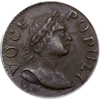 |
1760 Hibernia-Voce Populi Farthing. Large letters. PCGS graded AU-58. A rare coin indeed, and especially as the finest graded by PCGS! It is alone in the AU-58 grade, and none have yet been graded as Mint State. Sharp on the central obverse and around the periphery, the only sign of weakness is located at the central reverse. Medium brown in color and smooth save for an ancient slightly rough area located on the lower obverse. If you demand the finest for your colonial collection, then you'll have a field day in this sale, with this particular coin circled in your catalog. An exceptional example of this rare issue.
Estimated Value $4,500 - 5,500.
View details and enlarged photos
| Realized
$5,290 |
Lot 5 |
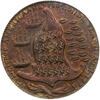 |
(c. 1779) Rhode Island Ship Medal, with wreath. PCGS graded MS-64. All Rhode Island ship medals are rare, especially this variety. The surfaces of this one are exceptional, and show no significant or even minor signs of handling. The color too is choice, with brassy and copper highlights, and no troubling spots or detracting toned areas. Fully struck, with as much detail as possible given the state of the dies, and somewhat primitive conditions which likely prevailed when these were struck. One small edge flaw is noted at the bottom of the obverse, which is present on both sides of the coin. PCGS has graded 4 in all grades, with the being the finest seen by that service. The legends have been subject to various interpretations over the years, but Breen's seems the best, "The Americans had run away in 1778; now there goes Admiral Howe the same way in 1779." The Revolutionary War skirmishes referred to were the American and French forces which abandoned Conanicut Island in order to pursue Howe's forces on ships in 1778, but a storm forced both sides to withdraw. Admiral Howe soon took control of the small Island off Narragansett Bay, but he was forced to withdraw 15 months later, as the American and French forces prevailed. On the original issue, the Dutch word VLUGTENDE (fleeing) was seen just below Howe's ship, but this word was scraped off most coins, and the dies were changed to show a pair of branches or sprigs below. Breen suggests that the reference to fleeing could result in reprisals by the British, so the dies were changed. Nothing like the threat of a long stay in Newgate Prison to make one very careful about such things.
Estimated Value $6,000 - 7,000.
View details and enlarged photos
| Realized
$6,900 |
Lot 6 |
 |
1713-D. 30 Deniers. PCGS graded AU-50. A nice example of this scarce issue, the color is natural in appearance and the surfaces clean.
Estimated Value $500 - 750.
View details and enlarged photos
| Realized
$518 |
Lot 7 |
 |
1713-AA French Colonies 15 Deniers. PCGS graded AU-58. Referred to as a "Demi Mousquetaires" or "Half Mousquetaires" piece. Very rare as a denomination, and especially so for the date of 1713. Complete silvering save for the very highest devices which show a trace of darker gray on the high points. This is the rosette variety, which appears after the date at the top of the crown. Breen notes that these are all very rare, and this variety he states "4 or 5 seen."
The coinage from the French Colonies was first issued under the Royal Edict of February 1679, and the coins were intended to circulate in Canada, Aradia and the French Carribean. Later, more coins were issued under the Edict of September 1709, which called for billon coinage in the denominations of 15 and 30 Deniers. Billon consisted of both copper and silver. Apparently, these circulated well as most are found in extremely low grades. Around 1720 John Law set up his abortive scheme for land speculation in the Mississippi region. Bank notes were issued backed by land, and precious little silver or gold as backing. After the disastrous consequences unfolded, coinage became quite scarce in the region (Stack's Roper sale, 1983).
Struck at the Paris Mint, this coin somehow survived in wonderful condition, despite the rusted dies used to the coin it. Nearly identical to the Roper coin offered by Stack's in 1983, but this is a different die pairing.
Estimated Value $1,000 - 1,250.
View details and enlarged photos
| Realized
$633 |
Lot 8 |
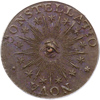 |
1783 Nova Constellation Copper. Pointed rays, small U.S. PCGS graded MS-62 Brown. Light brown in color and well struck, including the center all seeing eye. The fields show scattered red patina, as often found on copper of this period or earlier and some devices are affected. PCGS has only graded 1 coin this high, with just 2 graded higher, both MS-63 brown, making this one likely high in the condition census for the issue.
Under the new Confederation, Gouverneur Morris tried to locate a consistent source for uniform coinage. Silver was scarce in America, so he focused on copper by traveling to England and requesting help from the Birmingham mints. Although lacking authority to act, many believed Morris was ready to contract out the much needed copper coinage, and patterns were prepared by various mints. This is one such pattern issue, designed by George Wyon III, after Benjamin Dudley, and struck at Wyon's Mint in Birmingham. These were coined at 60 or 55 or even 72 to the pound of copper. Many circulated in America for years after issue. Finding a mint state example is nearly unheard of, and collectors would do well to put this one away before it disappears into someone else's collection.
Estimated Value $2,500 - 3,000.
View details and enlarged photos
| Realized
$2,588 |
Lot 9 |
 |
1786 Immunis Columbia Pattern. Eagle reverse. PCGS graded AU-55. One of the finest graded of this rare pattern issue, PCGS notes that this coin is alone as the sole AU-55 graded, with 4 coins graded higher by that service. Designed and coined by James F. Atlee prior to his joining the Mint at Machin's Mills, these were patterns for contract coinage for the Confederation, either with the Rahway Mills Mint or on his own.
The proposal was made by Gen. Ogden, the bondholder for the Rahway Mills Mint, who had copper mines and the ability to meet the coinage demands of the new Confederation of States. Ogden's proposal no doubt included several examples of this 1787 Immunis Columbia pattern, and these were turned over to the Confederation Board of Treasury's nefarious chief, Col. William Duer. Unbeknownst to Ogden, the contract had already been awarded to James Jarvis, in consideration of a $10,000 bribe to Duer (Breen's Encyclopedia). In short order, Jarvis had to flee the country as he could not meet the demands of the contract, as he had no source for the copper, and Jarvis stayed in Europe to avoid the $10,842 judgment against him. Before Ogden received the bad news of the contract award to his competitor (the bribing Jarvis), Ogden had Atlee strike a large number of the 1787 Immunis Columbia coppers. These coins circulated at 14 to the shilling, when they were accepted, and many circulated for many years.
A most important offering for the Colonial specialist.
Estimated Value $5,000 - 7,500.
View details and enlarged photos
| Realized
$4,830 |
Lot 10 |
 |
1787 Massachusetts Half Cent. PCGS graded MS-64 Brown. A rare coin in this grade, with fully struck devices and alluring glossy dark brown tones. PCGS has graded 15 this high, and 4 higher of this important colonial issue. This one will delight the specialist in every way and is certainly worth a strong price.
Estimated Value $3,500 - 4,000.
View details and enlarged photos
| Realized
$4,025 |
Lot 11 |
 |
1787 Connecticut Copper. Horned bust variety. PCGS graded AU-58. This is an excellent example of the "horned bust" variety, which refers to the heavy die break which extends upwards from Liberty's bust into the field near her chin. Splendid light brown in color, with smooth surfaces and decent centering on the usual small planchet. While we're not sure of the provenance of this coin, it is not the Garrett coin as that was an early die state. This one is currently the finest graded by PCGS, and alone in this grade category, making the importance of this offering very significant. Believed to have been coined in New Jersey by the Morristown Mint, and engraved and coined by Walter Mould and Benjamin Dudley. Struck on small, thin flans weighing 105-115.5 grains. A foremost opportunity for the specialist.
Estimated Value $1,250 - 1,500.
View details and enlarged photos
| Realized
$3,565 |
Lot 12 |
 |
1787 New York "Excelsior" Copper. Eagle facing left. PCGS graded AU-55. Excelsior, the very name is part of the holy grail of United States Colonials, for it is tied directly to the famed Brasher Doubloon of the same date and to the die maker of each, John Bailey. Perfect light brown in color, the devices are generally well struck and enhanced by slightly darker hues in the fields that surround them. A touch of weakness on the small central shield, with the sun over the mountains and rays above weak, perhaps as much from die failure as strike. Quickly identifiable by a small dig at the center of the shield on the reverse, although we were unable to trace this one to any previous auctions. A classic rarity in any grade, and this particular coin is certainly one of the very finest known. Breen estimates that 15-20 are known, and that seems too high. Many of the great colonial collections of the past several decades did not have a specimen, and those that did often could only locate a rather low grade piece.
These patterns were struck by John Bailey and possibly for Ephram Brasher as state coinage proposals for New York, they incorporate the State Arms of New York on the obverse, the reverse with the Great Seal of the United States loosely copied with a large eagle with outstretched wings, E PLURIBUS UNUM around, and 1787 below. These New York arms are found on that state's paper currency issue of April 18, 1786, as engraved by Peter Maverick (Breen). Their heraldic blazoning: "Sun rising over three mountains, sea in foreground, all proper; crest, eagle surmounts demi-globe on torse; dexter supporter, Liberty with cap and pole; sinister supporter, Justice, with scales." EXCELSIOR, or "More excellent, more noble," is the state motto: (Newman).
As to rarity, PCGS has graded just two examples, this coin as by far the finest in AU-55, on one other grading EF-40. Although a different example, this one is very similar in grade to the Garrett coin offered in 1979. This particular coin is a later die state, and that may account for the central obverse weakness. Note the rim crumbling below the date and around the periphery. Many are poorly struck and off center, this one is well centered and rather sharp for the issue. Others are listed below. A foremost opportunity, and we feel this colonial is underrated and may prove to be far rarer than currently reported, once the pedigree chains are connected and further research is accomplished.
Estimated Value $20,000 - 30,000.
Purchased in a private transaction a few years ago. The best listing of these we could locate was published in Bowers and Merena's Norweb sale, March 1988, and we thank them their for research on this rare issue:
1) The present specimen, PCGS graded AU-55
2). Bowers & Ruddy's Garrett Sales, November 1979: 599 AU-50.
3). Bowers and Merena's Norweb Part II Sale, March 1988: 2681 Very Fine 35., purchased privately from New Netherlands, December 11, 1954 by the Norwebs.
4). Stack's Park Sale, May 1976: 58 (unknown grade, but Very Fine or lower)
5). Stack's John L. Roper, 2nd Sale, December 1983: 271, ex Merkin Sale, October 1973: 121 Very Fine
6). Stack's Donald Groves Sale, November 1974: 334, Fine to Very Fine
7). Stack's Robison Sale, February 1982: 152, a strong Fine.
8). Stack's FPL, 1989, item C153, Fine, ex: Andrew C. Zabriskie, H. Chapman, June 3, 1909, lot 77, plated.
9). Stack's FPL, 1986, item C41, Very Good.
10) New Netherland's 60th, December 1968: 414, Fine to Very Fine, plugged.
View details and enlarged photos
| Realized
$24,150 |
Lot 13 |
 |
"1787" Machin's Mills Copper Halfpenny. PCGS graded VF-20. All the Machin's Mills coins are scarce and popular as they were struck in New York. This specimen shows a decent strike from the dies, and the surfaces are finely porous and dark. For the Machin's Mills issues, most are on defective planchets and frequently are poorly struck and weak. PCGS hasn't graded a whole lot of these, so far just 20 in all grades, the finest seen in AU-50, and most grade below EF. This is the small date variety, listed in Early American Coins by Robert A. Vlack as variety 17-87A.
Estimated Value $550 - 600.
View details and enlarged photos
| Realized
$368 |
Lot 14 |
 |
1787 Nova Eborac. Figure facing right. PCGS graded EF-40. An extremely important issue from John Bailey and struck in New York City around 1787. The quatrefoil punches (the small 4 petal flowers after the legends) match those of the extremely rare Excelsior pattern issues and the famous Brasher Doubloons, as well as the 1788 New Jersey coppers, which links these coins to John Bailey. Apparently these were issued as proposals to the State of New York to win the contract for making coins, but enough of these are around to indicate that they were made for circulation, and not strictly pattern issues. This particular one was struck on a clean planchet, and is an even brown color, with no signs of porosity or similar detractions. The surfaces are choice, but we will mention a few faint scrapes on the lower left of the obverse near the rim, and a trivial planchet flake on the jaw. A later die state, as are many, with the quatrefoil after LIB weak, and a long rim break from that area towards Liberty's toe. Sharply struck throughout, and about as nice as one could hope to locate. The seated right variety is much scarcer than the seated left. PCGS has only graded 3 as EF-40, with a single coin graded higher as AU-53. No mint state coins have been graded of this variety. Further, this one is in the old green insert PCGS holder. Truly an exceptional colonial for the specialist.
Estimated Value $1,500 - 2,000.
View details and enlarged photos
| Realized
$1,093 |
Lot 15 |
 |
1788 Vermont Copper. PCGS graded EF-45. Benson. This appears to be the Round Head, one obverse star variety (Breen-726). The obverse device is sharply struck especially on the uniform. PCGS has graded 5 this high, with 3 graded higher, and none in mint state. Scarce and always in demand as state coinage has really started to come into its own the past decade.
Estimated Value $1,200 - 1,500.
From our Benson Collection I, February, 2001, lot 85.
View details and enlarged photos
| Realized
$1,093 |
Lot 16 |
 |
1787 Auctori Plebis Token. PCGS graded AU-55. One of the finest graded of this rare and popular colonial issue. PCGS in their Population Report shows just 1 graded as AU-55 and 1 graded higher as AU-58, no mint state coins are reported, making this one of the very finest to have come down to us today.
These were struck to imitate the then current Connecticut coppers on planchets which were too small to accommodate the reverse die, and the tops of the lettering and bottom of the date is always missing. The obverse die was weakly engraved so simulate wear, and thus encourage acceptance. On the reverse, there is a die crack from Liberty's head extending down to the left. AUCTORI PLEBIS means "by the authority of the commoners" (Breen) and this has an antiroyalist flavor, the reverse legend of INDEP. ET LIBER "Independence and Liberty" which was copied from the Connecticut reverse legend. Most likely these were struck at the Birmingham mints between early 1788 and July 1789 when the copper panic stopped profitable business.
Light brown in color, with a few scattered ticks on the obverse, and one small stain on the B of PLEBIS should help trace the pedigree. Well struck for the issue, despite the late reverse die state.
Estimated Value $1,250 - 1,750.
View details and enlarged photos
| Realized
$2,415 |
Lot 17 |
 |
1794 Franklin Press Token. PCGS graded MS-65 Brown. This is the finest graded by PCGS, and it is alone as the sole MS-65 graded as Brown. There are a few Red and Brown examples graded, but they top out at MS-64. Gorgeous light brown in color on this one, with some mint red near the devices and no spots or other detracting marks. If you demand the finest, and want a regal example for your collection, then here is a boldly struck gem which is second to none.
Estimated Value $4,000 - 5,000.
View details and enlarged photos
| Realized
$7,475 |
Lot 18 |
 |
1795 Talbot, Allum & Lee Token Cent. PCGS graded MS-64 Red. Here is a significant rarity, this is the only "red" 1795 Talbot graded by PCGS! Not only that, but the surfaces of this near gem are quite beautiful and undiminished by marks or annoying spots. Well struck and preserved, this one must have been tucked away at the time of issue, and somehow retained most of the original mint color. Slightly faded, but clearly a very impressive coin for the mint color and surface quality. The reverse is especially nice in the color arena.
Estimated Value $1,500 - 2,000.
View details and enlarged photos
| Realized
$3,910 |
Lot 19 |
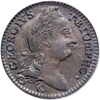 |
1783 Georgius Triumpho Token. PCGS graded AU-58. One of the finest graded of this rare and important colonial issue. Although little is known about the origin of the Georgius Triumpho coppers, we do know that there is an unfortunate resemblance to George III, and many are thought to have been defaced as such. These are thought to have circulated in the areas that became the states of Georgia and Florida, and others were exported to Jamaica. It is believed that no portrait of Washington was available, so an Irish halfpence was loosely copied for the head of Washington. The reverse design elements depict Lady Liberty weaving on a frame with 13 vertical stripes for the colonies, and four fleurs de lys at the corners, a tip to the vast help received from the French during the Revolution. All seen show a strong reverse die break through the weaving frame, on the left of the lady weaver. Excellent surfaces for the issue, with medium to dark brown toning evenly across both sides. One tiny red spot will identify between TR of TRIUMPHO. Free of handling or circulation problems.
Estimated Value $1,500 - 2,000.
View details and enlarged photos
| Realized
$4,025 |
Lot 20 |
 |
1783 Washington Token. Large military bust. PCGS graded MS-62 Brown. One of the finest graded of this variety, and the surfaces are nice for the grade assigned. We note a tiny scrape left of the & on the obverse, and the color is medium brown and free of problems. Sharp at the centers, but weak on parts of the peripheral lettering on the left side. Doubling is noted on the dentils on the right, and this one may be slightly double struck. PCGS has only graded 1 coin as such, with 1 graded higher, as MS-63 Brown, and 1 other as MS-62 Red and Brown for the top three seen by that service. An important example for the specialist.
Estimated Value $1,800 - 2,200.
View details and enlarged photos
| Realized
$2,990 |
Lot 21 |
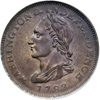 |
1783 Washington Token. "UNITY STATES". PCGS graded MS-63 Brown. A stunning and magnificent example of this Birmingham issue. Note the satiny brown luster on both sides and this is likely one of the only examples that retains mint color. Bluntly struck, as are all, with the tops of the peripheral letters and devices poorly struck up. The surfaces are exceptional for the moderate grade, and no signs of spots or discoloration of any size are present. PCGS in their population report show that this coin is the finest graded and alone as the sole MS-63. There are four others graded just below as MS-62. We can scarcely imagine a nicer example, with such lovely color, surfaces and rich history.
For many years, the origins of this token were unclear. As so often is the case in numismatics, years of research and analysis of minute details has solved this riddle. The dies are believed to have been engraved by Thomas Wells Ingram, of the Soho Mint around 1820. Other dies from this same maker are signed with a small "I" on Washington, and one seen has TWI, which linked this colonial to the Soho Mint around 1820. The date "1783" refers to the Treaty of Paris and the ending of the Revolution. It is apparent from the reverse that it was copied from the Large cents of 1796-1807, and these tokens were intended to circulate along side still scarce Philadelphia Mint regular cent issues. As copper coins were not legal tender in the United States, there were no laws against the import and circulation of copper tokens. As we know, the Philadelphia Mint could scarcely keep up with demand, and many areas still lacked small coins to make change. Hence merchants could order kegs of these tokens, and give them out as change without violating any laws. The copper coin shortage came to a head during the 1815-1817 period, when large cents were far more expensive to purchase compared with these tokens, which could be had for much less than one cent each, and given out as cents in change. The monetary history of the United States is rich with dozens of tokens and other stop gap measures that have been employed to keep the wheels of commerce turning when other coins were not available. An outstanding coin that will enhance even the most advanced collection.
Estimated Value $3,000 - 3,500.
View details and enlarged photos
| Realized
$5,290 |
Lot 22 |
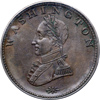 |
(c.1783) Washington Token Double Head Cent. PCGS graded MS-62 Brown. One of the finest graded of this important coin, PCGS has seen only 4 this high, with none graded higher! Mottled brown in color, with areas of darker shades near the rim and on the devices. All Washington colonials are scarce and have been popular since the time they were made. A timeless classic.
Estimated Value $1,800 - 2,200.
View details and enlarged photos
| Realized
$3,220 |
Lot 23 |
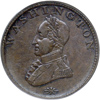 |
(c.1783) Washington Token Double Head Cent. PCGS graded AU-50. Choice light brown colors in the fields, with darker areas hugging the devices. Sharply struck and well preserved. Ever popular and always in high demand.
Estimated Value $500 - 600.
View details and enlarged photos
| Realized
$460 |
Lot 24 |
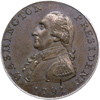 |
1791 Washington Token Cent. Large eagle. PCGS graded MS-65 Brown. Designed and engraved by John Gregory Hancock, Sr. (1775-1815) the child prodigy of Birmingham who became one of the finest engraving artists in the rich history of British diemaking. This particular work was done by Hancock at the ripe old age of 16. Washington is portrayed in elegant fashion, copied from a French period engraving of the time (see Breen's Encyclopedia). On the reverse we see a robust eagle, wings outspread and form fitting to the restrictions of a round planchet. In his beak a ribbon reads UNUM E PLURIBUS with ONE CENT above. Even the eagle's tail shows seven feathers, and this issue would arise in 1878 when Morgan dollars suffered an excess tail feather until some sharp eyed coiner noticed the offending feather and had it removed from future dies. Hancock also employed the lucky number 13 in both the number of leaves and arrows, representing the colonies that had banded together at that time. Why was such effort paid to small details, well, the American Congress was meeting to decide if they should contract out coinage, or have it made at home. This coin was one of Hancock's proposals for contract coinage. As the need for coinage was great at the time, the approximately 2,500 large eagle cents sent to America entered circulation, with just a few held back as mementos. Today, we have the benefits of hindsight, and know that soon a mint was established in Philadelphia by 1793, and contract coinage proposals were scrapped. PCGS, in their population report note that this is the finest "Brown" coin graded, alone in the MS-65 category, and there is only a single coin graded this high as "Red and Brown". The surfaces are pristine, the color and even brown with hazy brown luster beneath. One tiny planchet streak above the second 1 in the date will help to identify this coin, as well as a short lint mark hanging off the top left of the N of PRESIDENT. Thus, we can state that this is certainly one of the finest known examples of this ever popular and beautiful Hancock proposal for contract coinage.
Estimated Value $3,000 - 4,000.
View details and enlarged photos
| Realized
$4,715 |
Lot 25 |
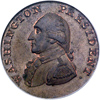 |
1791 Washington Token Cent. Small eagle. PCGS graded MS-66 Brown. Tied with a total of 4 coins as the finest graded by PCGS for this important issue. The surfaces are simply outstanding, with light to medium brown color throughout, and hints of original red clinging near the devices. Fully struck by the dies, with excellent details on the epaulet and ruffles. These issues were no doubt examined when the time came to strike the first regular issues in Philadelphia, as certain design elements were employed, like the arc of clouds above the eagle, instead of the full circle as seen on the Great Seal. Certain to please the most advanced collector of Washingtonia.
Estimated Value $5,000 - 6,000.
View details and enlarged photos
| Realized
$8,050 |
Lot 26 |
 |
1792 Washington Copper Token. Eagle with stars on reverse (no grade, host coin about EF). An impressive electrotype example of this extremely rare coin. As was the practice in the last two centuries, when a collector could not obtain an original example of a rare coin, a copy might be made from a friends collection or from a willing museum that had an example desired. Such is the case here, this coin is made from a cast of the obverse and reverse of an original out there somewhere, and the two halves are fused together. Rare and seldom offered in any grade, this glossy tan example makes for a nice filler until a real one is offered again.
Estimated Value $200 - 250.
View details and enlarged photos
| Realized
$150 |
Lot 27 |
 |
(1792) Washington Token Copper Cent. "WASHINGTON BORN VIRGINIA". SEGS graded EF-40 holed, repaired and expertly plugged. * holder. Our grade Sharpness of Extremely Fine, net grade Fine-12. As noted on the SEGS "*" holder, this coin has been holed, plugged at 11 o'clock on the obverse and expertly repaired. Dark patina from slightly rough surfaces that have been carefully smoothed and this work is scarcely detectable. As to the hole, the letters in that area are not as crisp as on the rest of the coin, but this work is very well done and hardly noticeable. This is an example of Breen's second die (B-1239). In the PCGS Population Report we note that only 9 have been graded of this rare coin, 7 in grades of VF or below, and 2 in AU, with none graded in mint state. A rare and seldom offered coin, and one that should be considered by any specialist in the series despite its problems.
Estimated Value $2,000 - 3,000.
View details and enlarged photos
| Realized
$1,898 |
Lot 28 |
 |
(1792) Washington Token Cent. "WASHINGTON PRESIDENT", plain edge. SEGS graded Fine-15 "*" holder. Light Roughness. A very rare issue that is seldom found at all. PCGS has yet to grade an example of this colonial. While the surfaces are not perfect, with a minor bend along the left side of the obverse and reverse, and surface marks located on the central reverse. Dark brown in color, with an old spot on Washington's coat, and another behind his shoulder. The coin continued to circulated after the surface marks, so the wear is not even on the reverse, with many words only partially legible. Not bad for what it is, and worth a decent bid.
Estimated Value $1,500 - 2,500.
View details and enlarged photos
| Realized
$2,645 |
Lot 29 |
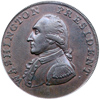 |
1793 Washington Token Halfpenny. Ship reverse, lettered edge. PCGS graded MS-62 Brown. Although the mintage is unknown, we do know that PCGS has graded 105 of these according to their recent Population Report. Of the 105 only 3 have been graded in mint state, one in each grade MS-60, 61 and this coin alone as MS-62. There are none graded higher. Breen speculates that these ship tokens were imported for circulation, and were not made for the collecting public in England, which accounts for their rarity in high grades. This is an early die state, when the overdate is still present under the 3, and the die had not yet clashed and started to rust as seen on a great many examples. Reddish brown in color, and very well preserved. The surfaces show no troubling spots or other signs of contact. Washington is fairly well struck with most of the details on the epaulets and on his curls. The ship too, is outstanding, with full rigging, sails and flags above. If you demand the finest, then here is one that certainly may qualify of this rare Hancock-Washington issue.
Estimated Value $4,000 - 5,000.
View details and enlarged photos
| Realized
$6,440 |
|
|